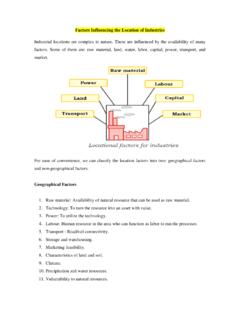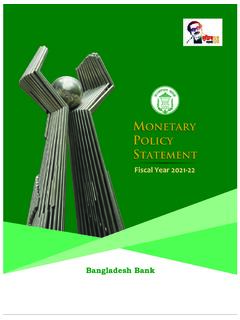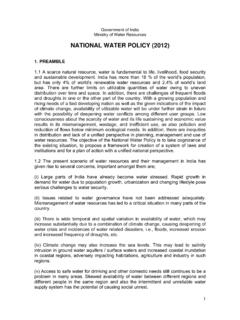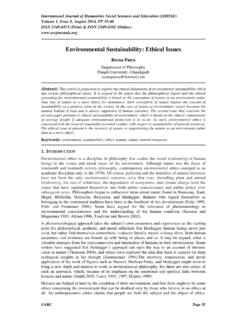Transcription of WHAT IS SUSTAINABLE DEVELOPMENT INTRODUCTION
1 1 Unit-IV BPA-602 SEMESTER-VI Issues in Public Administration what IS SUSTAINABLE DEVELOPMENT INTRODUCTION SUSTAINABLE DEVELOPMENT today it is the most politicised catchword of international developmental conferences and programmes. what does it mean? We address this question right in the beginning of the unit. You will discover that it is a multidimensional concept and its interpretation and understanding is often content and context specific. SUSTAINABLE DEVELOPMENT has emerged out of the fears of depleting natural resources and a subsequent slowing or even closing down of much of the economic activities and production systems. It is the result of rapacious misuse of earth s precious and limited resource base by those few who had a control over production systems. The concept has emerged as a broad framework to debate and decide on desirable direction of change in social and economic systems, policies, programmes and actions at the national, community or individual levels.
2 It developed in the 1960s when people became aware of the detrimental effects of industrialisation on the environment. You need to understand the context in which it came about to appreciate why it has become so important to all of us. You must also recognise that sustainability offers long term planning for productive techniques, industrial processes and equitable distribution policies for the exploitation of resources, such as, to name a few, coal, oil and water. This planning ensures their longer life span and a broader user base so that the greatest number of people may benefit out of it for the longest possible time frame. The emergence of the idea of sustainability also strikes at the indispensability of technological transformation towards energy saving devices, alternate and non-conventional systems for providing comfort to citizens without bringing down their quality of life.
3 This has led to a total revolution in the way people and governments have started thinking and designing their developmental programmes and projects. A new respect has emerged for the grassroots governance which fuels growth by providing land, water and forests that constitute the three basic inputs to any form of industrialisation. Thus SUSTAINABLE DEVELOPMENT is also indicative of planning from below in contrast to the ivory tower planning from top in which grassroots ecosystems were driven by technological systems. As a result, the grassroots ecosystems started to wither away as they were not able to manage and cleanse the high amount of effluent discharges, pollution and resource overuse. In the next unit, we introduce the various parameters that characterise SUSTAINABLE DEVELOPMENT .
4 Objectives After studying this unit, you should be able to: explain the meaning and origin of the concept of SUSTAINABLE DEVELOPMENT ; describe the fundamental principles of SUSTAINABLE DEVELOPMENT ; and identify and analyse the indicators of unsustainable growth. 2 MEANING OF SUSTAINABILITY, DEVELOPMENT AND SUSTAINABLE DEVELOPMENT Nature provides human societies and economies with a complex life support system, air, water, food and a suitable climate for survival. It also provides the physical resources that are necessary for the sustenance of economies. Nature has supported and maintained life on earth since times immemorial and should continue to do so in the future. This is known as the sustainability of nature or ecosystems or environment. However, we have been interfering with the sustainability of the natural systems through our avaricious activities and if we continue on the same trajectory, not only the other life forms but also the very existence of mankind is threatened.
5 There are limits to nature s capacity to absorb impacts. Once alteration of nature s initial state occurs, it cannot quickly revert back to the initial state. Nature has a limited capacity to withstand rapid change. Thus, today, the challenge before mankind is to determine the state in which we wish to live and to continue living within the limits inherent in nature s processes, within nature s carrying capacity. Sustainability The term Sustainability has been defined variously, such as: Sustainability refers to a process or state that can be maintained indefinitely. Natural resources must be used in ways that do not create ecological debts by overexploiting the carrying and productive capacity of the earth. A minimum necessary condition for sustainability is the maintenance of the total natural capital stock at or above the current level.
6 The term Sustainability is also used to demonstrate the temporal and the livelihood context of DEVELOPMENT policies. The temporal context refers to the chronological perspective in which communities maintain their cultural and economic integrity. The livelihood context of DEVELOPMENT policies is the preservation of existing values which are under threat from external economic forces leading to the collapse of a delicate natural resource balance. The Strategy for SUSTAINABLE Living (1991) by International Union of Conservation of Nature and Natural Resources (IUCN) says that SUSTAINABLE use means use of an organism, ecosystem, or other renewable resource at a rate within its capacity for renewal . The economist Herman Daly has offered specifications for maintaining sustainability. He is of the opinion that: Rates of use of renewable resources should not exceed regeneration rates.
7 Rates of use of non-renewable resources should not exceed rates of DEVELOPMENT of renewable substitutes. Rates of pollution emission should not exceed assimilative capacities of the environment. DEVELOPMENT The term DEVELOPMENT means the social and economic improvement in a broad sense. It is needed to create opportunities, prosperity and choices for all inhabitants of the world and it must proceed in a way that leaves choices available for future generations also. It refers to a holistic growth of the human and natural environment towards autonomy and freedom. It indicates a growth pattern, which makes nations more decisive in their internal and external environment. 3 SUSTAINABLE DEVELOPMENT The concept of SUSTAINABLE DEVELOPMENT was envisaged to bring environmentalist ideas into the central theme of economic DEVELOPMENT policy.
8 It sought to modify the kind of unsustainable DEVELOPMENT strategies that were being pursued. SUSTAINABLE DEVELOPMENT combines the two terms of sustainability and DEVELOPMENT to indicate a pattern of growth, which strengthens both the national capabilities to care for their people in relation to their total relationship with the resources of the earth. The most widely used definition of SUSTAINABLE DEVELOPMENT was given by the Brundtland Commission in its report Our Common Future (1987). It defined SUSTAINABLE DEVELOPMENT as DEVELOPMENT , which meets the needs of the present without compromising the ability of future generations to meet their own needs . Since then, several interpretations of SUSTAINABLE DEVELOPMENT have emerged, for example: Improving the quality of human life while living within the carrying capacity of supporting ecosystems.
9 economic growth that provides fairness and opportunity for all the people, not just the privileged few, without further destroying the world s finite natural resources and carrying capacity. SUSTAINABLE DEVELOPMENT comprises of economic and social DEVELOPMENT that protect and enhance the natural environment and social equity. Thus, SUSTAINABLE DEVELOPMENT focuses upon a relationship between humans and their environment and indicates a warning that humans cannot push DEVELOPMENT , which is against nature as in the end it is always the nature, which is going to win. SUSTAINABLE DEVELOPMENT encourages the conservation and preservation of natural resources and of the environment and the management of energy, waste and transportation. SUSTAINABLE DEVELOPMENT is DEVELOPMENT based on patterns of production and consumption that can be pursued into the future without degrading the human or natural environment.
10 It involves the equitable sharing of the benefits of economic activity across all sections of society, to enhance the wellbeing of humans, protect health and alleviate poverty. If SUSTAINABLE DEVELOPMENT is to be successful, the attitudes of individuals as well as governments with regard to our current lifestyles and the impact they have on the environment will need to be changed. Objectives of SUSTAINABLE DEVELOPMENT SUSTAINABLE DEVELOPMENT has some forward looking and broad based objectives, which transcend class, caste, language and regional barriers. These objectives are a charter for liberating one s economy from the clutches of exploitative mind set, which has depraved nations and defied their biomass wealth. These objectives are: 1. To maintain the standards of living of the largest number of people with equity and justice.











